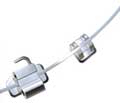During the last decade, the specialty of orthodontics has undergone a technological revolution. New materials and techniques are constantly being developed that can make braces less noticeable, improve patient comfort and, in some cases, reduce treatment time and help control costs.








In the past, individual bands, usually of stainless steel, were wrapped around and cemented to each individual tooth. The band served to secure orthodontic attachments. While effective, it created the "tin grin" look that some patients found unappealing. Today, the practice of bonding brackets directly on patients' teeth is possible and are much less noticeable.
Another innovation in orthodontics is what is sometimes referred to as "Space Age" wires. These new wires, which have been developed through the NASA space program, are made from resilient metals which are more flexible and retain a pre-formed shape.
These wires are easier for orthodontists to apply and require fewer wire replacements, which can reduce the number of visits to the orthodontist for adjustments. The end-result often is less discomfort and shorter treatment time for the patient.
Among a variety of materials, BIDC also uses the Unitek Nitinol Archwire system. These archwire systems provide a linear elasticity and bendability of high strength steel. The Unitek Nitinol Heat Activated archwire thermally activates super-elastic archwire. To date, only nickel titanium can deliver the elastic working range making it easy for the Nitinol wires to engage and delivers the light continuous forces that effectively move teeth.
Less visible-clear or tooth-colored-brackets are rapidly gaining in popularity. These aesthetically appealing braces are available in translucent white, to blend with the teeth, or in a clear, transparent material that allows the natural color of teeth to show through. Because they are not as noticeable, these braces can boost the patient's self-esteem and help eliminate the self-consciousness that may be associated with wearing metal braces.
For those patients who want complete "obscurity," lingual braces may be an option. Lingual braces are applied to the inside surfaces of the teeth. Many people (especially professionals such as lawyers, doctors and sales representatives) opt for these "hidden" braces. It's important to discuss this option with an orthodontist as lingual braces are not applicable to all orthodontic problems.
Considerable publicity has been given to functional or removable appliances (braces). While conventional braces apply pressure directly to teeth, functional appliances are used in different ways. Some are intended to influence growth of the jaws in order to effect changes in facial structure. Some are used to retain teeth in the corrected positions. They also are often used prior to and in conjunction with conventional braces. Functional appliances have been available for a long time, but new ideas and techniques are now being used with them. Again, functional appliances are not applicable to all cases and should be checked with your orthodontist.
Elastics, the small rubber bands used with braces, now come in colors from neons to pastels. Braces-wearers can change their elastics to coordinate with their outfits, or they can be festive for holidays.
Retainers, usually worn after the braces are removed, can also be personalized and made in colors other than the traditional roof-of-the-mouth pink.
